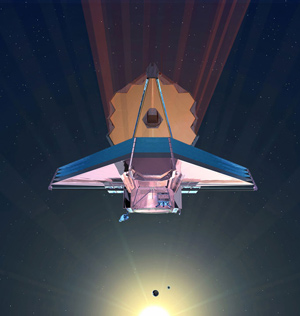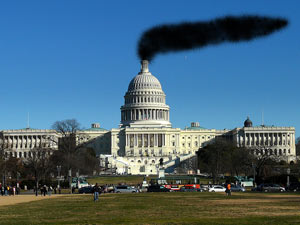 The James Webb Space Telescope is planned to be the successor to the Hubble Space Telescope. It will have a 6.5 meter (21 foot) mirror (Hubble’s is 2.4 meters, or 8 feet), and will look at the Universe in the near- to mid-infrared, where cooler objects like planets, dust clouds, and ancient galaxies glow brightly.
The James Webb Space Telescope is planned to be the successor to the Hubble Space Telescope. It will have a 6.5 meter (21 foot) mirror (Hubble’s is 2.4 meters, or 8 feet), and will look at the Universe in the near- to mid-infrared, where cooler objects like planets, dust clouds, and ancient galaxies glow brightly.
Its fate also hangs by a thread.
Originally planned to cost under a billion dollars and already be launched by now – NASA has currently spent about $3.5B on the mission with a launch date no sooner than 2018 – delays and cost overruns have hit the project hard, prompting the US House of Representatives to axe the budget for JWST, essentially killing the entire project in their proposed 2012 Federal budget. I wrote about this when the news broke, basically saying this was a dumb idea. The JWST cost overruns have been widely claimed to be from administrative mismanagement. Even if true, as Julianne Dalcanton at Cosmic Variance has eloquently argued, those errors are behind us. The components of the telescope are mostly built, being tested now, and it would make more sense to spend the money it’ll take to assemble and launch the ‘scope than to cancel the project and throw away the investment already made.
Now two bits of news have come up which confuse the issue.
One is that, according to Aviation Week, a cost analysis ordered by Senator Barbara Mikulski (D-MD) shows that the current price tag of the telescope will actually be $8.7 billion, an increase of more than $3B over an earlier NASA estimate.
Ouch. Bluntly put, that’s a huge blow to any campaign to save the telescope, and will make convincing this current Congress to fund the mission once again much, much harder.
The second bit of news (reported by Nature) is that NASA is looking to defray some of the extra cost by sharing it across the agency’s budget. NASA has different sections, called Directorates, with different goals, like Aeronautics, Space Exploration, and so on. JWST is under the Science Directorate, and is the flagship astrophysics mission. The idea now, to keep JWST going, is to get roughly $500 million of the needed costs from the other Directorates.
I’m of two minds on this. One is that it makes sense; JWST is a very big NASA priority, not just for science but for the Agency itself (the parallels with Hubble are pretty clear; it was the NASA flagship observatory as well and in many ways was the public face of the space agency). Splitting up costs across NASA itself reflects that.
On the other hand, if this happens, it takes money away from other projects. A lot of money. NASA has a finite budget – only about $18B annually, which may sound like a lot but is in reality a tiny drop in the Federal budget ocean. It’s facing cuts thanks to the new Tea Party Congress, cuts I am strongly against. But with one of its biggest projects running hugely over budget and way behind schedule, NASA is facing a terrible choice. Cut JWST, or borrow from Peter to pay Paul.
 And even that cost defraying maneuver has to be approved. If the Senate agrees to cut JWST in their version of the Federal budget, then this is all for nothing. Until recently I would’ve bet against that – Barbara Mikulski is a fierce defender of NASA (Goddard Space Flight Center and the Space Telescope Science Institute are both in Maryland, but to be honest I get the impression she’s a science advocate anyway), but now I’m not so sure. When the panel ordered by Senator Mikulski says JWST is that far over budget, then the game may change.
And even that cost defraying maneuver has to be approved. If the Senate agrees to cut JWST in their version of the Federal budget, then this is all for nothing. Until recently I would’ve bet against that – Barbara Mikulski is a fierce defender of NASA (Goddard Space Flight Center and the Space Telescope Science Institute are both in Maryland, but to be honest I get the impression she’s a science advocate anyway), but now I’m not so sure. When the panel ordered by Senator Mikulski says JWST is that far over budget, then the game may change.
So the political reality of this is now more complicated. As I said, it made sense to continue JWST when the major costs were behind us, but with this new information that may not be politically viable. I’ve worked on NASA projects in the past, and seen them get hit when some other mission needed more funding. It’s frustrating, and makes the affected project more difficult (sometimes causing a cascade effect – a mission gets delayed and needs more money, so NASA takes it from another mission, which must be delayed because now its pool of money is lower, and so on). However, in a realistic sense, it’s better to have some woes and belt-tightening rather than the outright cancellation of a major project… as long as the belt-tightening doesn’t strangle the other work (if you’ll pardon the partially mixed metaphor).
There is, of course, an obvious solution: Congress should fully fund NASA instead of starving it of needed assets. One area in which I agree with Congress is that there is a lot of waste in government, so I’d like to see that cleaned up and the money found put to actual, good use. JWST is a truly incredible mission. It will see farther than any telescope of its kind before. It will look at planets orbiting other stars, stars forming in nearby galaxies, and the light emitted from objects at the most distant realms of the Universe.
Just as importantly, it will once again reinvigorate the American public about science. This cannot be stressed enough. Hubble was also over budget and behind schedule, and the history of getting that eye in the sky is loaded with political games and NASA difficulties that would sound very familiar to those hearing the tales of JWST. Yet Hubble triumphed. Today, people don’t even think about the malfunctioning mirror embarrassment that made headlines for weeks; they just see the stunning images and profound scientific insights provided by the telescope. And they want more.
We can’t know just what JWST will see, and how it will further our knowledge. We simply know that it will, and that the images it takes will set the curiosity and minds of people afire.
There are many worthy things the government can spend money on, of course. But I think that an investment in the future of science, and in stoking the public’s imagination about the Universe, is well worth it.
JWST image credit: NASA
Related posts:
- Congress threatens America’s future in space
- Congress puts NASA and JWST on the chopping block
- Hubble Gotchu 2
- Wealth of science
- What value space exploration?
- How deep the Universe
- Why explore space?